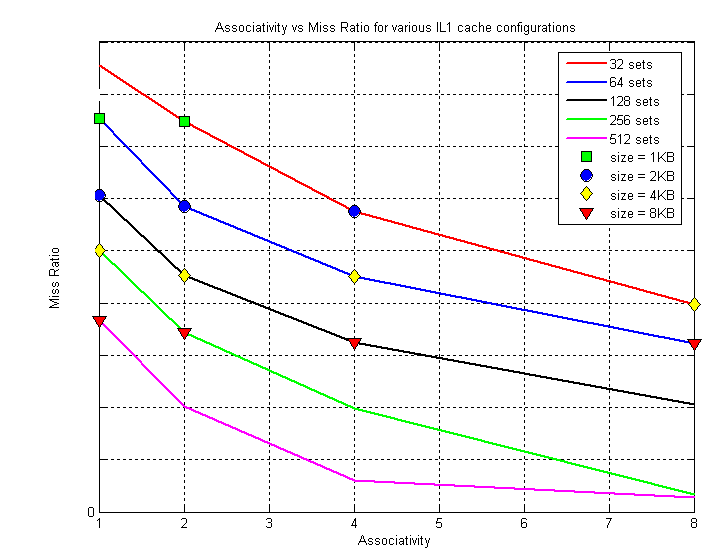
Cache Organization & Associativity
In this lab you will get introduced to sim-cache simulator. You will use this simulator to do cache simulation with various configurations.
Quick fact about sim-outorder
simulator
It
is a memory
system simulator. This simulator can emulate a system with multiple levels of
instruction and data caches, each of which can be configured for different sizes
and organizations. This simulator is ideal for fast cache simulation if the
effect of cache performance on execution time is not needed.
All the
simulators including sim-cache are available in
the home/simplesim-3.0 directory.
home/simplesim-3.0$./sim-cache
–h
Make
sure that the simulator is configured as PISA Simulator,
perform the following exercises on test-math
program
available in home/simplesim-3.0/tests-pisa/bin/ directory.
1) Use a single run of sim-cache to simulate the performance of the cache under the following conditions:
| Miss Ratio (I-Cache) | 1-way | 2-way | 4-way | 8-way |
| 32 sets | ||||
| 64 sets | ||||
| 128 sets | ||||
| 256 sets | ||||
| 512 sets |
| Miss Ratio (D-Cache) | 1-way | 2-way | 4-way | 8-way |
| 32 sets | ||||
| 64 sets | ||||
| 128 sets | ||||
| 256 sets | ||||
| 512 sets |
Now use MATLAB or EXCEL to plot the results of the simulations. For each of the simulations (data, instruction), plot the miss ratio versus associativity for each number of sets. Using markers, show the points on the curves which correspond to total cache sizes of 1 Kbytes, 2 Kbytes, 4 Kbytes and 8 K bytes (total cache size = sets * block size * associativity). For each simulation, you should produce something that resembles the plot below. In the plot results are shown from the instruction cache simulation.

Now answer the following questions based on the above results.
Q 1) For a given number of sets, what effect does increasing associativity have on the miss ratio?Q 2) For a given associativity, what is the effect of increasing the number of sets?
Q 3) For a given cache size, how does the miss ratio change when going from an associativity of one to two to four? Explain.
Q 4) If you were to design a Instruction cache, limited to a total cache size of 4 Kbytes, which cache organization would you choose, based solely on performance?
Q 5) If you were to design a data cache, limited to a total cache size of 4 Kbytes, which cache organization would you choose, based solely on performance?
Bonus Part
Repeat part 1) for only Instruction cache except that change the replacement scheme from LRU to Random. Plot the results as shown in the above figure. You don't need to answer the questions in part 1).